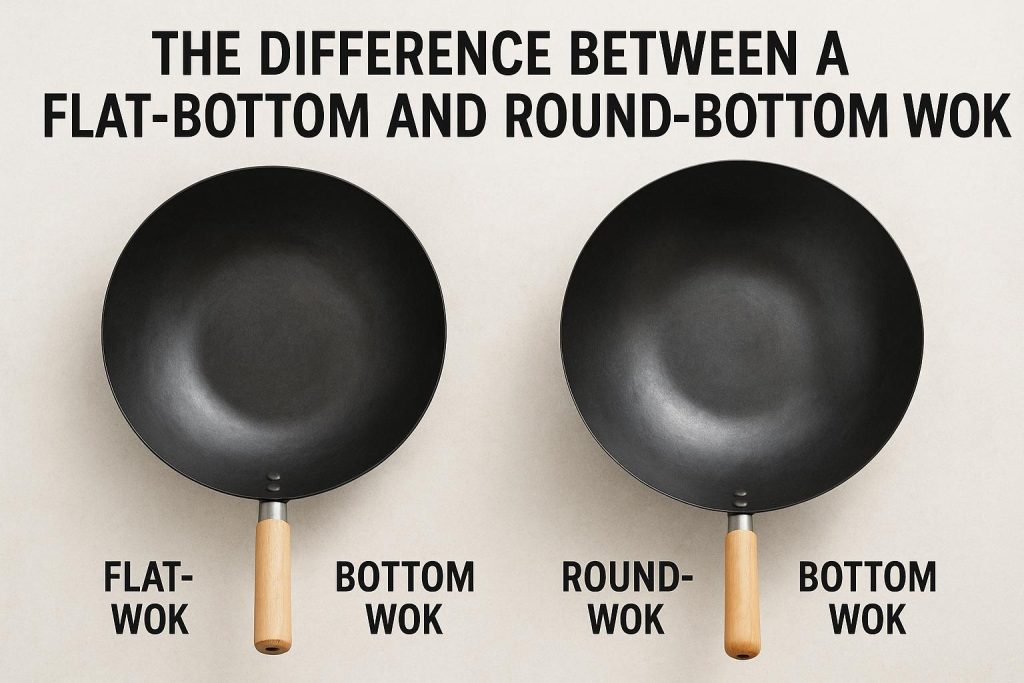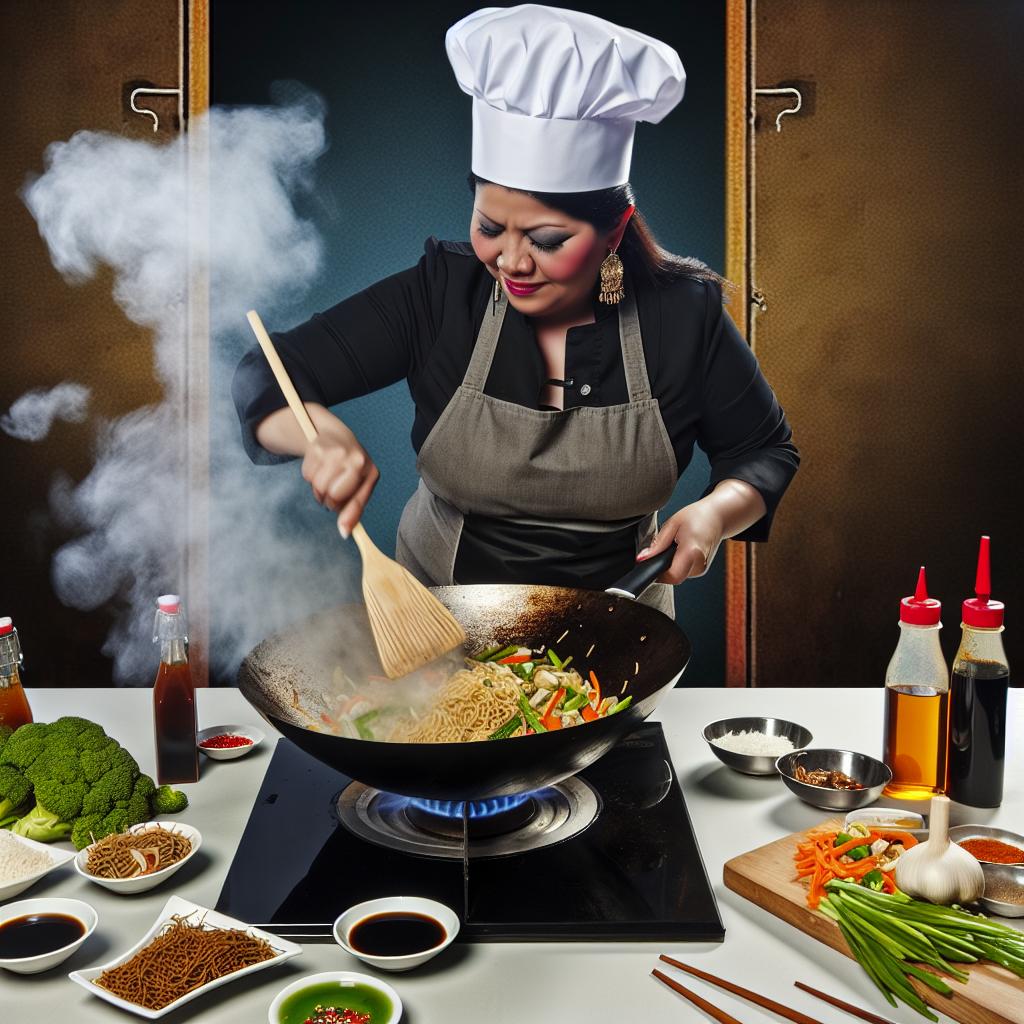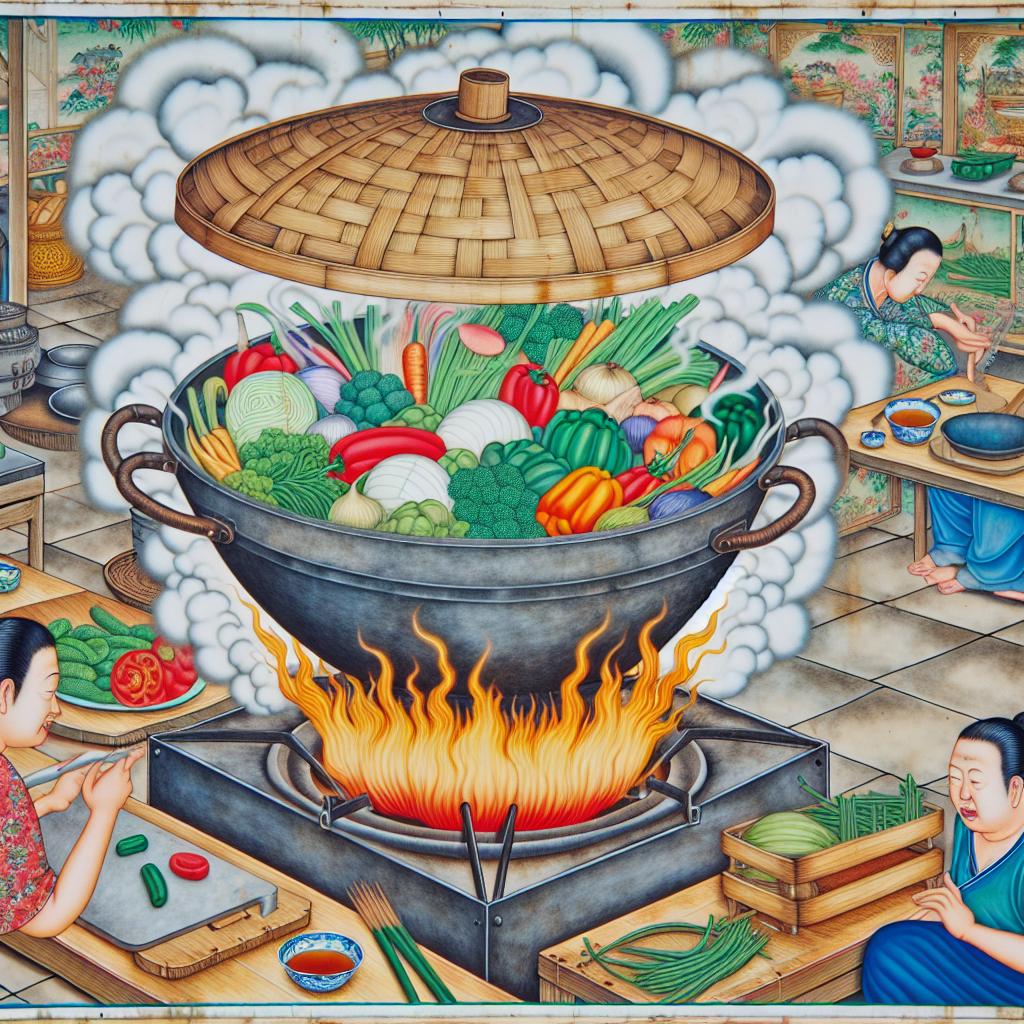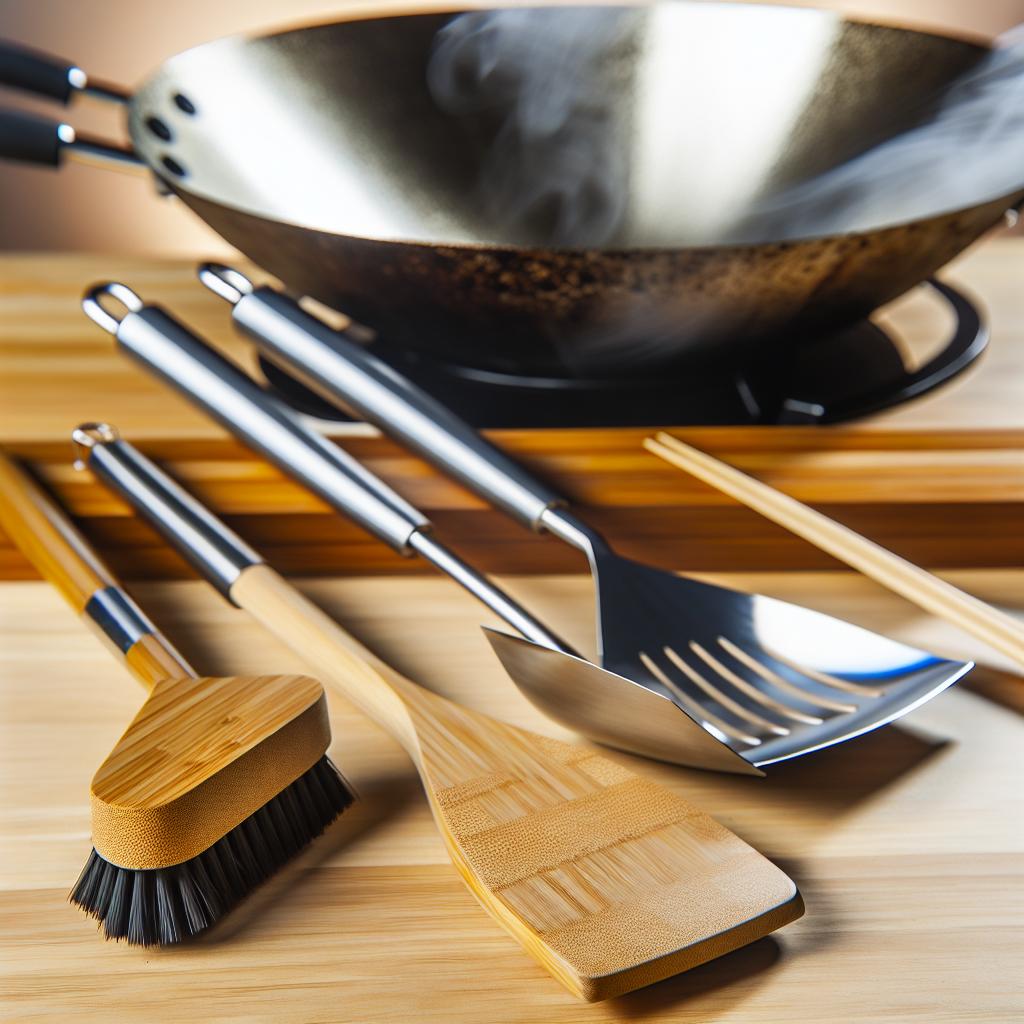Understanding Wok Shapes: Flat-Bottom vs. Round-Bottom
When it comes to equipping your kitchen with the right tools, selecting the appropriate wok can greatly influence your culinary experience. The choice between a flat-bottom or round-bottom wok is essential, as each design caters to different cooking methodologies and kitchen environments. Here, we’ll delve deeper into the distinct attributes and benefits associated with these two types of woks, providing an insightful perspective to guide your decision-making.
Design and Functionality
The design of a wok plays a crucial role in its functionality. A flat-bottom wok, specifically crafted to sit evenly on flat surfaces, proves to be advantageous for homeowners with electric or induction stovetops. This type of design ensures uniform heat distribution, thus aligning perfectly with the infrastructure of most Western kitchens. Furthermore, the flat-bottom wok’s design creates a sturdy interface with stovetop heating elements, thereby enhancing its overall cooking efficiency.
In contrast, the round-bottom wok shines in traditional gas cooking setups. Its unique curved shape is not merely for aesthetics but serves an important function in culinary practices. When stir-frying, this curvature allows the ingredients to flow naturally back to the center, promoting even cooking and reducing the need for constant manual stirring. As a result, users can effortlessly achieve the much-coveted stir-fry texture and flavor. Additionally, this design caters to the rapid, high-temperature cooking or “wok hei” – a vital characteristic in Asian cuisine.
Heat Distribution and Cooking Style
How heat is distributed across a cooking instrument can significantly affect the final output of your dishes. Flat-bottom woks ensure substantial contact with a heat source when utilized on flat stovetops. This extensive surface contact leads to rapid heating and even cooking, attributes that are particularly beneficial for quick stir-frying. Therefore, for those who prioritize swiftly attaining high temperatures for short-duration cooking, a flat-bottom wok may be the ideal choice.
On the other hand, the round-bottom wok is a champion in environments where high, centralized heat sources are present. This style of wok intensifies and focuses heat at the bottom, a feature that is indispensable for classic Chinese cooking techniques. The intense heat at the wok’s center allows for proficient implementation of traditional stir-fry techniques, facilitating the unique flavor profiles that define authentic Chinese cuisine.
Stability and Ease of Use
Stability is a decisive factor when considering ease of use, especially for individuals newly exploring the realm of Asian cooking. The flat-bottom wok offers remarkable steadiness provided by its stable connection with the stovetop. This feature is particularly beneficial for users who are still gaining comfort and confidence in wok handling and ensures ease in ingredient tossing and stirring.
Conversely, a round-bottom wok might initially challenge those unfamiliar with its handling demands. Such woks typically require additional accessories, like a wok ring, to ensure stability on Western-style stovetops. While this added need for stabilization might present a learning curve, many enthusiasts of traditional techniques find the extra effort worthwhile for the culinary rewards a round-bottomed design offers.
Material and Maintenance
Material selection is another critical aspect of choosing the perfect wok. Various materials such as carbon steel, cast iron, and stainless steel are employed in wok construction, each imparting unique benefits. Carbon steel, for instance, is favored for its excellent heat conductivity and relatively lightweight nature, offering a balanced combination of performance and ease of handling. Moreover, carbon steel adapts well during the seasoning process, a necessary practice to prevent rust and preserve the wok’s quality.
Cast iron provides excellent heat retention, albeit at the sacrifice of some weight and maneuverability, while stainless steel presents an attractive maintenance option due to its resistance to rust. Notably, regardless of the wok’s material, consistent seasoning and maintenance techniques are critical in extending the life and efficacy of your wok.
Choosing the Right Wok for You
Choosing between a flat-bottom and round-bottom wok depends greatly on your individual cooking preferences and the specifics of your kitchen setup. A flat-bottom wok is highly versatile, suitable for various stovetops, and typically more convenient for Western homes. This wok style seamlessly integrates into a wider range of cooking environments, thereby catering to diverse culinary practices.
In contrast, if your culinary focus lies in the authenticity of traditional Asian cuisine, particularly where high-temperature stir-frying is predominant, a round-bottom wok is likely the better fit. This design is optimized for capturing the essence of “wok hei,” which is integral to many Asian dishes.
Both wok types offer distinct advantages and can significantly enhance your culinary toolkit. Carefully evaluating your cooking style and kitchen dynamics can aid in determining the optimal choice, ensuring that your selection aligns with your culinary aspirations. Through this understanding, you can make a discerning choice, augmenting your kitchen capabilities and culinary creativity.
Introduction to Traditional Lo Mein
Lo Mein is a quintessential Chinese dish deeply rooted in the culinary traditions of the region. This dish, known for its versatility and rich flavor profile, prominently features wheat flour noodles alongside a diverse array of vegetables and, typically, a chosen protein such as chicken, beef, shrimp, or tofu. The art of preparing traditional lo mein in a wok brings forth its outstanding flavors, utilizing high-heat cooking that leads to a delicious, quick-to-prepare stir-fry.
Ingredients
In crafting traditional lo mein, a selection of ingredients is necessary to achieve the perfect harmony of flavors:
Noodles: The foundation of this dish can be either fresh lo mein noodles or dried egg noodles, depending on availability and preference. These noodles are known for their ability to absorb flavors well while providing a chewy texture.
Vegetables: For a colorful and nutritious blend, incorporate a mix of vegetables. Common choices include bell peppers, whose sweetness contrasts beautifully with the other flavors; crisp carrots, offering a touch of natural sweetness and vibrant color; and bok choy, whose subtle flavor pairs wonderfully with the other elements.
Protein: The addition of a protein enhances the dish’s nutritional value and flavors. Options are varied and cater to different dietary preferences: succulent pieces of chicken or beef, tender shrimp, or savory cubes of tofu.
Flavoring Agents: The essential components that bring depth to lo mein are soy sauce, oyster sauce, and sesame oil. These sauces impart a savory, umami-rich flavor that is fundamental to the dish’s appeal.
Aromatics: Garlic and ginger play a crucial role in traditional lo mein, serving as the aromatic base that enhances the overall flavor profile of the dish.
Preparation of Ingredients
Proper preparation of ingredients is crucial to achieving a seamless cooking process, especially as stir-frying demands swift and precise actions.
Noodles: For fresh noodles, a simple rinse under cold water followed by draining is sufficient. Dried varieties require cooking as per the package instructions, aiming for an al dente texture, after which they should be rinsed with cold water to halt further cooking.
Vegetables: Thorough washing of vegetables is a preliminary step to remove any impurities. They should then be thinly sliced, ensuring they cook rapidly and evenly during stir-frying.
Protein: The preparation of the protein involves cutting it into bite-sized pieces. This preparation allows for quicker cooking and ensures each piece is uniformly exposed to heat, contributing consistent flavor and texture throughout the dish.
Cooking Process
The preparation of lo mein involves a series of sequential steps, each essential in crafting a dish that bursts with flavor and aroma.
Step 1: Heating the Wok
Begin by placing the wok over medium-high heat. Add a small measure of oil, heating it until it shimmers, a sign that it has reached the optimal temperature for cooking. This step is important, as it primes the wok and oil for stir-frying, helping to prevent sticking and ensuring even cooking.
Step 2: Cooking the Protein
The protein is the first to meet the heat of the wok; it is stir-fried until cooked thoroughly. Once done, it should be removed and set aside to prevent overcooking. This step not only ensures the protein is cooked perfectly but also enriches it with subtle flavors heightened by the high heat.
Step 3: Stir-Frying the Vegetables
If necessary, add a touch more oil to the wok. Sauté minced garlic and ginger first, releasing their potent aroma. Then, introduce the prepared vegetables, stir-frying them till they achieve a tender-crisp texture. The quick cooking preserves the vegetables’ vibrant colors and fresh flavors while maintaining their nutritional value.
Step 4: Combining Ingredients
Return the cooked protein to the wok, followed by the noodles. Pour in measured amounts of soy sauce, oyster sauce, and a dash of sesame oil. This combination of sauces contributes layers of flavor, encapsulating the essence of the stir-fry. Thoroughly tossing the ingredients ensures each component is evenly coated with the flavorful mixture.
Step 5: Final Adjustments
Perform a taste test to gauge the seasoning, adjusting the soy or oyster sauce to your liking. The goal is a balanced blend where all elements are in harmony. Quickly remove the wok from heat as soon as you achieve the desired taste, preventing any risk of overcooking, which could affect the dish’s intended textures and flavors.
Serving Suggestions
Serving lo mein is best done while the dish is still hot, as this is when the flavors are most pronounced. It can be served directly from the wok, bringing a touch of authentic dining experience to the table. For added flavor and visual appeal, garnish with freshly chopped scallions or a sprinkle of sesame seeds. These garnishes introduce a fresh aroma and a slight crunch, enriching the overall dining experience. For culinary enthusiasts seeking further inspiration, explore additional recipes available on a range of cooking portals.
Conclusion
Traditional lo mein stands out not just for its taste but also for the unique balance of flavors and textures it offers. Its popularity across the globe attests to its enduring appeal. Cooking the dish in a wok not only reflects authenticity but also results in a delightful culinary creation that is gratifying in every bite. The methodical preparation and execution ensure a dish that is not only enjoyable but also a fulfilling culinary endeavor.
Steaming Food in a Wok: A Simple Guide
Steaming food in a wok is a versatile and healthy cooking method that preserves nutrients and flavors. This traditional technique is not only efficient but also adds a unique depth to your dishes. Below, you’ll find a step-by-step guide to mastering the art of steaming in a wok.
Equipment Needed
To steam effectively, you’ll need a few basic items. First and foremost, a wok is essential. Its sloped sides allow for even distribution of heat, making it perfect for steaming. Equally important is a steaming rack. This is a metal or bamboo accessory that sits inside the wok and holds your ingredients above the water. You’ll also need a lid; a tight-fitting one is crucial to trap steam and cook the food evenly. Finally, water is required—clean, fresh water is needed for creating steam and cooking your food effectively.
Setting Up
The setup process is straightforward, but doing it correctly ensures effective steaming. Begin by filling your wok with a few inches of water. It is crucial to ensure that the water level remains below the steaming rack, as direct contact with water can lead to boiling rather than steaming. Place the rack inside the wok ensuring it’s stable. The surface should be level, so the food doesn’t tip over during the cooking process.
Preparing Food for Steaming
Preparation of the food to be steamed is the next critical step. It’s important to wash vegetables, fish, or meat thoroughly to rid them of any residues or impurities. If you’re steaming items like fish or poultry, it’s advisable to season them lightly with herbs and spices for enhanced flavor. For vegetables, a sprinkle of salt and pepper will suffice.
Arranging the Food
Next, lay out the food evenly on the steaming rack. One should avoid overcrowding, as this can obstruct steam circulation and result in uneven cooking of the food. It’s also worth considering the varying cooking times of different foods when arranging multiple items for steaming. For instance, delicate vegetables such as spinach take less time to steam compared to denser ones like carrots or potatoes.
Steaming Process
After correctly arranging the food, cover the wok with the lid. Turn on the heat to a medium-high setting and allow the water to come to a boil. The steam generated will cook the food. The cooking time will vary based on the type and size of the ingredients. For vegetables, the time generally ranges from 5 to 15 minutes. Fish typically requires 8 to 10 minutes, while poultry can take 20 minutes or more, depending on its thickness.
Monitoring and Tips
During the steaming process, it’s vital to periodically check the water level to ensure it hasn’t evaporated completely. Add more water as necessary to maintain the steaming process. Be cautious when lifting the lid, as escaping steam can cause burns. It’s wise to use tongs or a cloth to handle the hot lid. Moreover, for meats, utilizing a food thermometer can help ascertain that they have reached safe temperatures for consumption.
The art of steaming in a wok cannot be overstated. It’s a simple yet effective method that enhances flavor while preserving nutritional value. As with any cooking technique, practice and minor adjustments for preference will lead to perfection. By mastering this method of cooking, you can easily produce rich, flavorful, and nutritionally dense dishes. Should you wish to delve further into ideas and techniques for wok cooking, explore additional resources that focus specifically on enhancing wok-cooked meals. This will give you a broader understanding of the diverse methods and benefits of using a wok, ultimately enhancing your culinary skills.
In conclusion, steaming in a wok represents a bridge between traditional cooking wisdom and modern dietary needs. It’s a technique that encourages healthy eating while delivering on taste and texture. With the right equipment, setup, and preparation, anyone can master this cooking style and start reaping its benefits. By perfecting your steaming skills, you can create flavorful, nutrient-rich dishes effortlessly, paving the way for healthier eating habits in everyday life. As more individuals strive for balanced diets, the art of steaming in a wok provides a reliable, efficient, and tasty solution for home cooks everywhere.
Introduction
Stir-frying is a time-honored cooking technique prominent in numerous Asian cuisines, cherished for its rapidity and its capacity to create flavorful dishes from a diverse range of ingredients. The essence of achieving the perfect stir-fry lies not only in the skill of the cook but also in the selection of appropriate utensils that facilitate this art form. This article delves into some of the ideal wok utensils that can significantly enhance your stir-frying experience.
Wok Spatula
A wok spatula, often referred to as a wok chuan, stands out as an indispensable tool in the realm of stir-frying. Its design, characterized by a subtly curved edge, is tailored to complement the round contours of a wok. This particular shape allows for the effortless turning of ingredients within the wok and aids in scraping off any food particles that might adhere to the bottom during cooking. Opting for a stainless steel spatula can prove advantageous due to its durability and the ease with which it can be maintained.
Wok Ladle
Another vital utensil in the stir-frying toolkit is the wok ladle, also known by its Chinese name, zhagao. Distinguished by a deep bowl and an elongated handle, the wok ladle excels in scooping sauces, broths, and larger quantities of stir-fried dishes. The use of a stainless steel ladle is recommended for its longevity, although materials like bamboo or wood might be preferable for maintaining the integrity of delicate or non-stick surfaces.
Alternatives to Traditional Wok Utensils
Despite the prominence of traditional tools in stir-frying, modern adaptations have emerged that serve similar purposes effectively:
Silicone Spatulas:
Ideal for non-stick woks, silicone spatulas prevent scratching and manage heat adeptly. They offer the added benefit of flexibility, which is particularly useful when flipping ingredients during cooking.
Tongs:
Especially convenient for handling larger food pieces, such as chicken or tofu. Silicone-tipped tongs are especially valued for their compatibility with non-stick woks, preserving the surface while allowing for careful maneuvering of ingredients.
Chopsticks
While not always regarded as essential, long bamboo or wooden chopsticks can serve as effective stir-frying tools. They are particularly useful for managing delicate or small ingredients, providing the cook with precision and control to maintain the texture of sensitive ingredients like tofu or leafy greens. Utilizing chopsticks can also offer the added benefit of refining dexterity in culinary handling.
Additional Considerations
In preparing for a successful stir-frying session, there are several factors beyond the mere choice of utensils that one must consider:
Wok Material:
The compatibility between the wok material and the utensils is paramount. Non-metal utensils are recommended for use with non-stick woks to avoid damaging their surfaces.
Handle Design:
The ergonomics of utensil handles play a crucial role. Comfortably designed handles are essential for a firm grip, particularly during prolonged cooking sessions.
Heat Resistance:
Given the high temperatures involved in stir-frying, it is imperative that your utensils have the capability to withstand such conditions without degrading. This ensures both the longevity of your utensils and the safety of the cooking process.
Conclusion
The selection of appropriate wok utensils can considerably augment one’s stir-frying prowess. Whether it be a traditional wok spatula or its modern counterpart, a silicone spatula, each tool plays a distinct role in crafting the ideal stir-fry. While mastery of stir-frying techniques can be self-taught, relying on resources and tutorials from reputable culinary websites or cooking schools online can provide valuable insights into more nuanced techniques, thereby enriching one’s culinary repertoire. In embracing these tools and considerations, cooks are better equipped to bring out the multifaceted flavors characteristic of this beloved cooking method.



